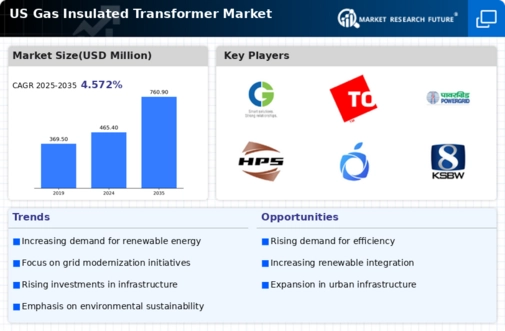Aging Electrical Infrastructure
The aging electrical infrastructure in the US poses a challenge that the gas insulated-transformer market is poised to address. Many existing transformers are outdated and inefficient, leading to increased maintenance costs and power outages. The need for modernization is critical, as studies indicate that nearly 70% of the US electrical grid is over 25 years old. Replacing these aging systems with gas insulated transformers can enhance reliability and reduce operational costs. This necessity for upgrades is likely to stimulate market growth, as utilities seek to invest in more efficient and durable solutions to meet the demands of a modern energy landscape.
Rising Demand for Renewable Energy
The increasing emphasis on renewable energy sources in the US is driving the gas insulated-transformer market. As utilities and energy providers transition towards cleaner energy, the need for efficient and reliable transformers becomes paramount. Gas insulated transformers are known for their compact design and reduced environmental impact. They are well-suited for integration with renewable energy systems. The market was projected to grow at a CAGR of approximately 6% from 2025 to 2030, reflecting the rising demand for sustainable energy solutions. This shift not only enhances energy efficiency but also aligns with national goals for reducing carbon emissions, thereby propelling the gas insulated-transformer market forward.
Increased Focus on Safety and Reliability
Safety and reliability are paramount in the energy sector, driving the gas insulated-transformer market. Gas insulated transformers offer enhanced safety features compared to traditional oil-filled transformers, reducing the risk of fire and environmental contamination. As regulatory bodies emphasize safety standards, utilities are increasingly adopting gas insulated technology to comply with these regulations. The market is expected to witness a growth rate of around 5% annually as companies prioritize investments in safer and more reliable transformer solutions. This focus on safety not only protects infrastructure but also ensures uninterrupted power supply, further solidifying the gas insulated-transformer market's position.
Urbanization and Infrastructure Development
Rapid urbanization in the US is significantly influencing the gas insulated-transformer market. As cities expand, the demand for reliable power distribution systems increases. Gas insulated transformers, with their space-saving design, are ideal for urban environments where land is at a premium. The US infrastructure bill, which allocates $1.2 trillion for various projects, is expected to boost investments in electrical infrastructure, including gas insulated transformers. This development is likely to enhance grid reliability and efficiency, further driving the market. The urbanization trend suggests a sustained growth trajectory for the gas insulated-transformer market as cities modernize their electrical systems.
Technological Innovations in Transformer Design
Technological innovations are reshaping the gas insulated-transformer market, leading to more efficient and compact designs. Advances in materials and engineering have resulted in transformers that are not only smaller but also more efficient, with losses reduced by up to 30%. These innovations are crucial as they allow for better integration into existing infrastructure, particularly in urban settings. The ongoing research and development efforts in transformer technology suggest a promising future for the market, with potential applications in smart grid systems and renewable energy integration. As these technologies mature, the gas insulated-transformer market is likely to expand, driven by the demand for cutting-edge solutions.






















Leave a Comment